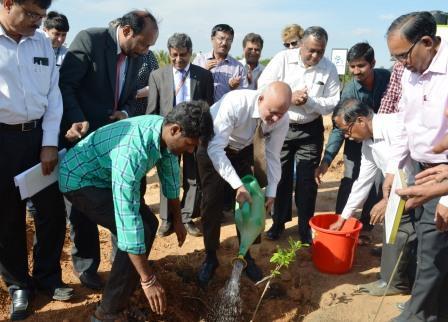Blog Fruits of labour: One year after establishing genetic garden in Bengaluru, India

A year after Bioversity International opened a genetic garden in Bengaluru, India, scientist Shankar Dandin reports on the impact of underutilized fruit crops in the region.
In April 2015, Bioversity International opened a genetic garden in Bengaluru, India that conserves native fruit plants. A year after the garden was established, scientist Shankar Dandin reports on the impact that underutilized fruit crops found in the genetic garden have on the region.
Underutilized fruit crops are recognized as crops of the future because of their multiple benefits, including nutritional value, medicinal properties and climate resilience. Though the importance of these crops was well recognized in traditional agricultural systems, because of monoculture practices, in which very few fruit crops are cultivated in a large area, other crops are slowly vanishing from cultivation. Minor fruit crops are found widely distributed in both of the hemispheres covering tropical, subtropical and some semi-temperate regions of the world. However, these fruit crops are found more abundantly in tropical and subtropical regions in the wild, and in rural areas, these species are found growing in yards and on farmland. Studies have reported that as many as 261 species can be found growing wildly.
Last year, Bioversity International inaugurated a genetic garden in Bengaluru, India, which became a ‘livable laboratory’ to safeguard rare species from the region. It was also created to study how these species can affect the nutrition and the livelihood of farming households and rural communities in southern India. The genetic garden is emblematic for Bengaluru’s position as a hotspot for biodiversity. Dr. Shankar Dandin reports on how the garden is faring after its first year.
On April 14, 2014, the Bengaluru center of Bioversity International in India established an ex-situ genetic diversity park to explore, collect, characterize and conserve underutilized fruit species from tropical and subtropical regions. Now, 152 varieties of 95 species have been planted in this ex-situ gene bank (see Table 1). Regular cultural practices are being used to understand how traditional knowledge of these fruits can be assimilated into local food preparation. For each variety of fruit, a description about its beneficial agrobiodiversity properties is listed, such as a fruit’s origin, flowering and fruiting season, the number of varieties, food value composition and use.
Even with this progress, there are still steps to take to move forward. Scientists are resurveying and documenting the variability of these food crops and updating the botanical descriptions of all of the species. Scientists are also trying to introduce these underutilized fruits to the market by conducting in-depth chemical analyses of the crops to better understand their nutritional value and industrial potential. To increase cultivation, scientists are currently developing propagation and multiplication protocols so that these fruits can spread from the garden to become available widespread for farmers. Scientists also plan to take a personal approach by working with farmers to standardize cultivation practices to increase both production and quality. We hope that these efforts, along with publicizing the benefits of underutilized crops, will empower local farmers to effectively conserve these rare fruits and sustainably grow them for years to come.
Contact scientist Shankar Dandin for more information about the initiative.
The genetic garden is supported by the Indian Council for Agricultural Research and the University of Horticultural Sciences, Bagalkot. Work funded by the International Fund for Agricultural Development (IFAD) and more recently, with additional support from the CGIAR Research Program on Climate Change, Agriculture and Food Security (CCAFS).
Photo: Distinguished guests plant trees at the Bangalore Living Laboratory opening ceremony. Credit: Bioversity International/A. Gupta
